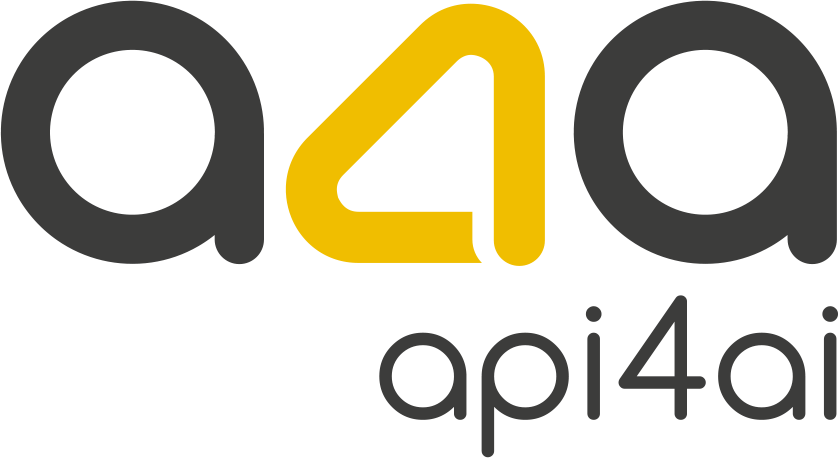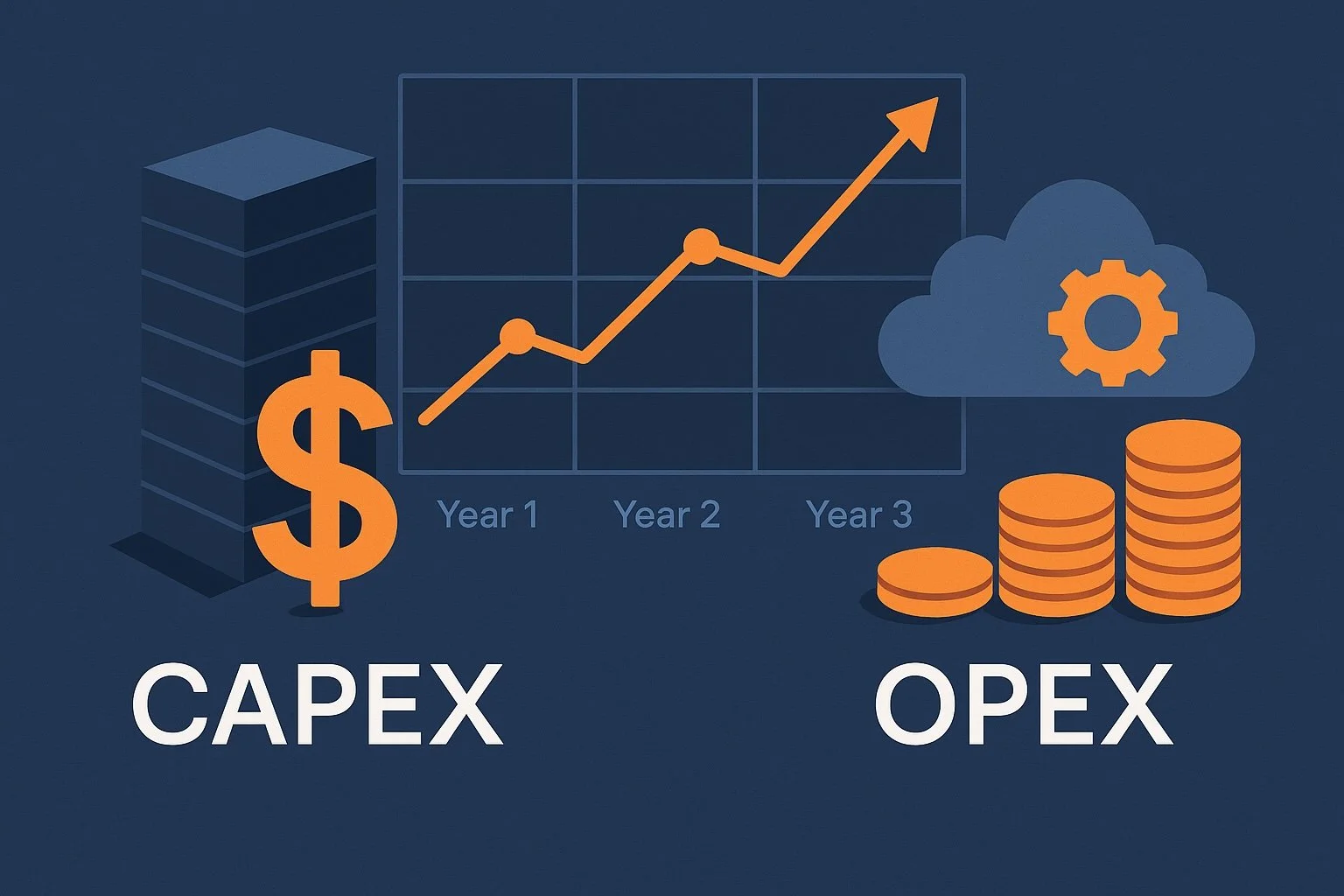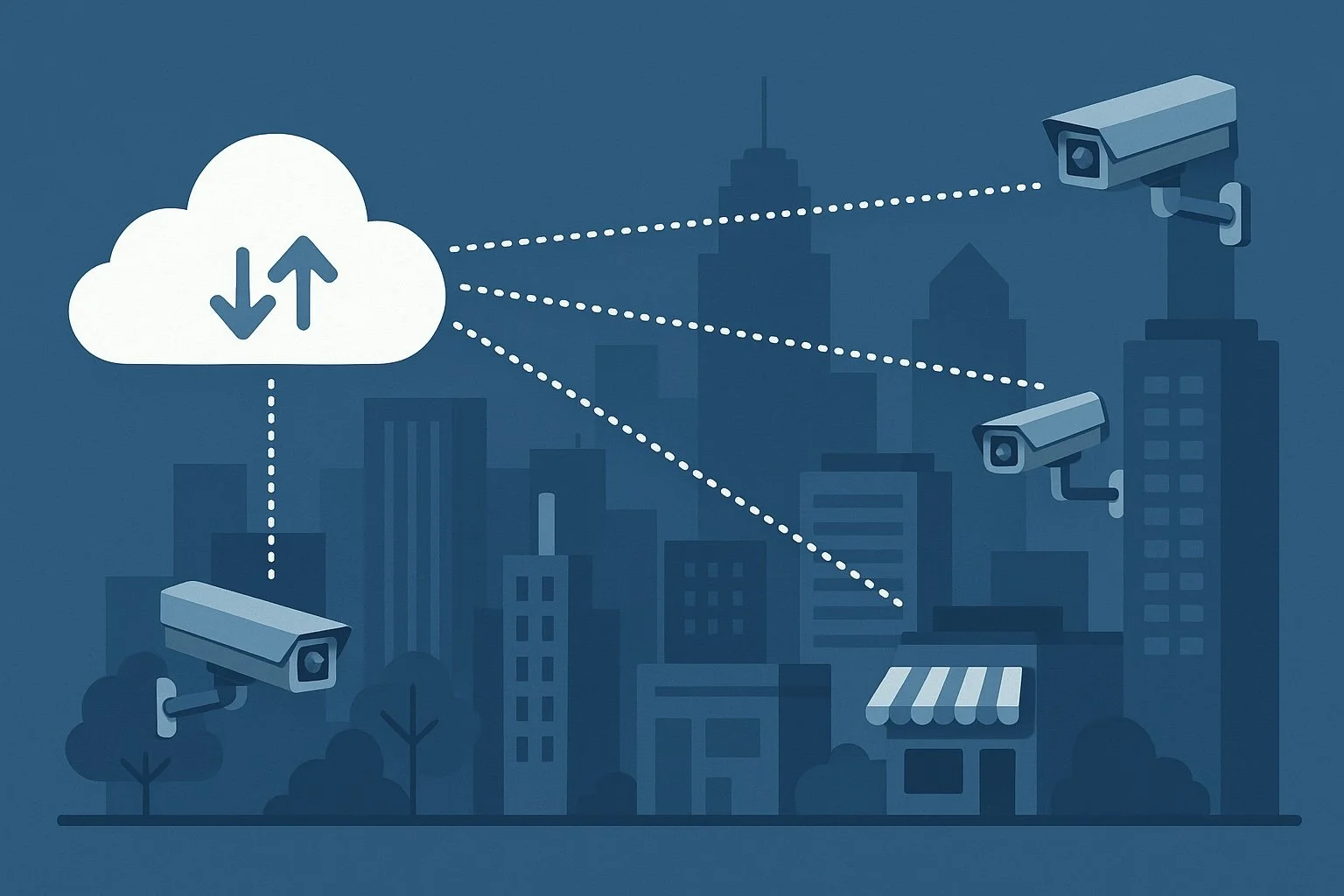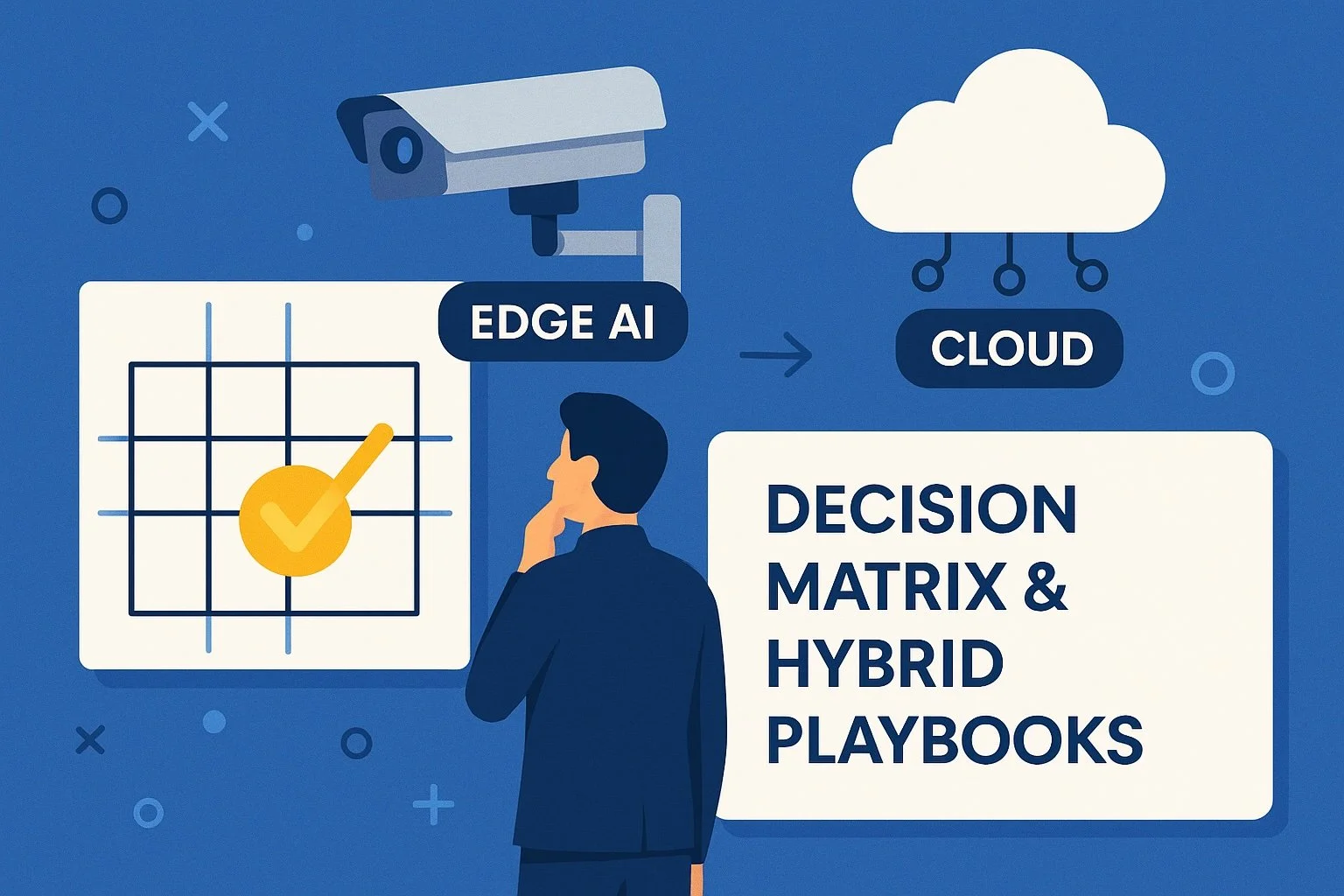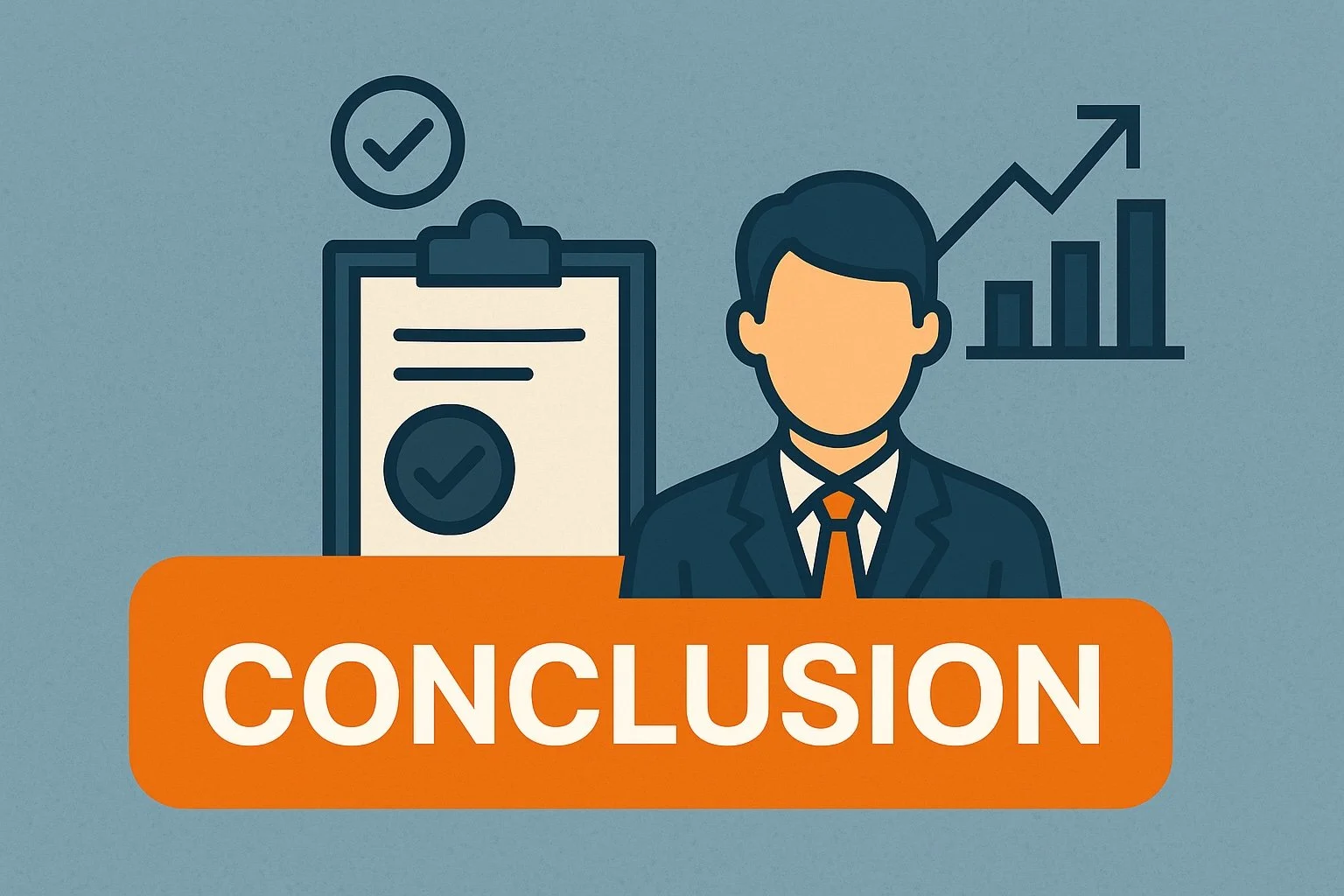Edge AI Cameras vs Cloud: Balancing Latency, Cost & Reach
Introduction
In an era where visual data fuels everything from retail analytics to industrial automation, business leaders face a critical architectural decision: should image and video processing happen on the edge or in the cloud? The answer has significant implications for latency, cost, scalability, data privacy, and long-term innovation capacity.
The rise of Edge AI cameras — devices that process data locally using embedded neural networks — offers the promise of near-instant decision-making and reduced reliance on connectivity. At the same time, cloud-based AI services continue to dominate in flexibility, ease of integration, and rapid access to powerful pre-trained models through APIs.
For C-level executives — especially CTOs, CIOs, COOs, and CISOs — the choice isn’t merely about technology. It’s about aligning digital infrastructure with strategic business priorities:
How fast must our systems respond to real-world events?
What is the total cost of operating a scalable AI-driven process over 3 to 5 years?
How can we maintain data sovereignty, security, and regulatory compliance without slowing innovation?
Do we have the internal capacity to build, deploy, and manage our own models, or should we leverage specialized providers?
With computer vision increasingly central to customer experience, operational safety, fraud detection, and regulatory reporting, understanding the trade-offs between edge and cloud deployment models has become a board-level concern.
This post provides a clear, structured framework for evaluating Edge AI Cameras vs Cloud-Based AI Processing, with an emphasis on:
Latency and responsiveness
Total cost of ownership (TCO)
Global scalability and infrastructure flexibility
Security and compliance risk exposure
Emerging hybrid strategies that blend the best of both worlds
You’ll also see how cloud-based APIs — such as object detection, OCR, logo recognition, or image anonymization — can plug into hybrid architectures for rapid rollout and long-term cost optimization.
The goal is not to argue for one model over another, but to equip decision-makers with the insights needed to select the right architecture for each workload, and to recognize the strategic opportunities that come with making the right call early.
Speed and Latency — When Every Millisecond Matters
In AI-driven systems, latency isn't just a technical metric — it directly affects user experience, safety, and operational performance. Whether it’s enabling real-time alerts on factory floors or supporting frictionless checkout in retail, the speed at which data is processed can determine the success or failure of a solution.
Edge AI cameras process visual data locally, on the device itself. This eliminates the need to send high-resolution images or video streams over a network to a centralized cloud. As a result, decisions can be made in under 100 milliseconds. This is especially valuable in time-critical scenarios such as detecting safety risks, controlling robotic systems, or enabling smart retail interactions. Since the data doesn’t leave the device, this approach also avoids delays caused by network instability or limited bandwidth.
Cloud-based AI, on the other hand, introduces unavoidable delays. Even with optimized infrastructure, transmitting data to the cloud and waiting for a response can take anywhere from a few hundred milliseconds to over a second, depending on the network conditions and server load. While this level of latency is perfectly acceptable for applications like document scanning, image cataloging, or periodic reporting, it falls short in situations that require immediate action.
The decision between edge and cloud processing should be driven by the latency sensitivity of each use case. Tasks that require fast reactions — such as identifying a production line fault or confirming a customer’s action in real time — are best handled at the edge. In contrast, use cases that tolerate longer processing times, like archival image analysis or post-event audits, are well suited for cloud-based AI.
In practice, many organizations adopt a hybrid strategy. Edge devices can handle quick, first-pass decisions locally and then forward selected data to the cloud for deeper analysis. For example, an edge camera might detect motion or a product in a scene, while the cloud runs more advanced recognition through APIs such as logo detection, object classification, or face analysis.
For decision-makers, this means latency should be treated as a strategic design parameter. It’s not just about making systems faster — it’s about unlocking business capabilities that depend on real-time intelligence. The closer your AI is to the moment of action, the more value it can deliver.
Cost and Total Cost of Ownership — Balancing Upfront Investment and Long-Term Value
For any large-scale AI deployment, cost is more than just hardware or API pricing. Total cost of ownership (TCO) spans infrastructure, development, bandwidth, maintenance, and operational efficiency. Understanding how these factors play out in edge and cloud architectures is essential for making sustainable, high-impact decisions.
Capital Expenditure vs Operating Expenditure
Edge AI systems typically require an upfront investment in hardware. Smart cameras with integrated AI chips, local storage, and industrial durability can cost several hundred to over a thousand dollars per unit. These costs are capitalized, but they lock up cash early and often involve additional spending on physical installation, environmental protection, and power supply.
Cloud-based AI services, on the other hand, follow a pay-as-you-go model. Instead of buying and managing devices, organizations pay for API usage. For example, image recognition APIs or OCR services are billed per transaction or per 1,000 requests. This operating expenditure scales linearly with demand and offers predictability during the early phases of adoption. However, it can also grow rapidly as data volumes increase — especially when video or high-resolution imagery is involved.
Hidden Bandwidth and Storage Costs
One often overlooked factor is data transmission. A single high-definition video stream can consume several terabytes of bandwidth per month. If this data is sent to the cloud for processing, outbound data transfer charges from cloud providers can add significant costs. In some cases, bandwidth alone may cost more than the actual inference processing.
Edge devices reduce this burden by processing data locally and sending only the results — such as tags, alerts, or cropped images — to the cloud. This not only lowers bandwidth consumption but also reduces cloud storage requirements and enables faster downstream processing.
Maintenance and Operational Overhead
Running AI on the edge introduces maintenance challenges. Devices in the field must be monitored, updated, and managed remotely. Firmware updates, security patches, and model versioning all require systems for over-the-air (OTA) deployment. This adds operational complexity, especially when scaling across multiple sites or regions.
Cloud-based models, in contrast, centralize the AI pipeline. Model updates, retraining, and performance improvements can be rolled out instantly without touching the edge infrastructure. This simplifies operations and allows internal teams to focus more on innovation than on logistics.
Long-Term Strategy and ROI
While cloud AI offers a faster path to deployment and simpler scaling in the early stages, edge solutions can be more cost-effective in the long run — particularly for high-volume, latency-sensitive, or bandwidth-intensive workloads. Organizations that invest in hybrid strategies often achieve the best of both worlds: fast local decision-making combined with scalable, centralized intelligence.
A thoughtful cost strategy should consider not only unit pricing but also how expenses evolve as the system scales. For instance, leveraging pre-built APIs — like object detection, background removal, or logo recognition — can reduce development costs significantly. When volumes justify it, custom computer vision models tailored to specific business needs may further reduce per-inference cost and improve accuracy.
For executives, the key is to model cost not just per device or API call, but per business outcome. Evaluating the value of faster response times, improved accuracy, or better compliance can reveal savings and gains that are not obvious from line-item budgets alone.
Scalability, Reach, and Operational Efficiency
As organizations expand their AI capabilities across products, locations, and markets, the architecture supporting those systems must scale with them. Choosing between edge and cloud approaches impacts not only how fast you can grow, but also how efficiently you can manage your teams and infrastructure.
Global Reach and Elastic Scalability
Cloud infrastructure provides virtually unlimited scalability. Whether you're launching a new service in another country or processing millions of new images during a product launch, cloud AI systems can scale up automatically without new hardware investments. Major cloud providers offer global data centers, which support regional compliance and deliver AI services close to end-users with minimal setup time.
This makes cloud ideal for companies that operate across multiple countries or want to deploy new services quickly without investing in physical devices or local infrastructure.
Edge AI, in contrast, requires a device-by-device rollout. Expanding into a new location means shipping, installing, and configuring new hardware. While this adds complexity and slows time-to-market, it also allows for local autonomy and independence from network connectivity — especially useful in remote areas or locations with unreliable internet.
A hybrid model, where edge devices handle initial processing and the cloud manages complex tasks or data aggregation, offers a balance between reach and control. This approach allows global coordination without compromising local performance.
Workforce and Operational Management
AI systems are only as scalable as the teams that manage them. Cloud solutions centralize model management, monitoring, and updates. Machine learning engineers can update a model once and deploy it instantly across the entire application, ensuring consistency and reducing maintenance overhead.
Edge deployments, on the other hand, require robust systems for remote monitoring, diagnostics, and updates. Without proper tooling, these demands can place a significant burden on IT and engineering teams, limiting how quickly new features or improvements can be rolled out.
For example, retraining a computer vision model in the cloud and deploying it through an API requires little effort compared to pushing the same model update to hundreds or thousands of edge devices. This operational load becomes a limiting factor unless managed with automation and orchestration tools.
Flexibility to Adapt
Cloud platforms also offer greater flexibility in adapting to new use cases. Business units can test new AI capabilities — such as logo recognition for brand monitoring or image anonymization for privacy compliance — simply by integrating existing APIs. This empowers faster experimentation without relying on the hardware team or local site managers.
With edge solutions, experimentation tends to be slower and more expensive. New features may require different processing capabilities, firmware upgrades, or physical adjustments to the camera setup. This can delay product cycles and introduce hardware dependencies that are difficult to unwind later.
Strategic Implications
For executives, scalability and flexibility are not just about infrastructure — they are about agility and resource leverage. Cloud systems make it easier to respond to market changes, deploy new services, and reduce dependency on in-house technical teams. Edge systems offer control and responsiveness but require more planning and operational investment.
In many cases, a hybrid architecture unlocks the best results. Edge devices can filter and preprocess data locally, while the cloud handles advanced analysis using scalable, ready-to-use APIs for object detection, classification, or custom recognition tasks. This setup supports fast local actions and central intelligence, all while keeping teams lean and focused.
Privacy, Security, and Regulatory Compliance
As AI systems increasingly handle sensitive visual data — such as faces, license plates, branded content, or internal operations — privacy, security, and compliance become top-level concerns. These factors can significantly influence the choice between edge and cloud deployment, especially for companies operating in regulated industries or across international jurisdictions.
Data Residency and Compliance Mandates
One of the primary concerns for global enterprises is data residency. Regulations such as GDPR in Europe, CCPA in California, and similar laws in Brazil, India, and the Middle East require that certain types of personal data remain within national borders. Cloud providers often address this by offering regional hosting options, but compliance can still be complex — especially if the AI workflow involves transmitting raw video or images containing personally identifiable information (PII) across borders.
Edge AI can simplify this challenge. By processing data locally and only transmitting results — such as metadata, alerts, or anonymized images — companies can avoid moving sensitive data off-site altogether. This greatly reduces exposure to data transfer regulations and makes internal compliance reviews faster and less risky.
Security Risks and Responsibilities
Cloud AI services typically offer strong security postures, including end-to-end encryption, access control, and enterprise-grade certifications like ISO 27001, SOC 2, and FedRAMP. These features make cloud systems attractive for companies that want to offload some of the security burden to trusted providers.
However, cloud-based architectures also expand the attack surface. Each data transmission is a potential point of vulnerability. In highly sensitive environments — such as financial services, critical infrastructure, or healthcare — some organizations prefer edge solutions to minimize data movement and reduce external dependencies.
Edge systems offer security benefits through data minimization, but they also introduce new challenges. Physical device tampering, inconsistent patching, and limited encryption capabilities on lower-end devices must be addressed through robust device management and secure update mechanisms.
Privacy by Design
Modern privacy frameworks emphasize the principle of minimizing data collection and processing only what is necessary. Edge AI aligns well with this philosophy. By filtering or anonymizing data at the source, edge systems can enforce privacy by design at a technical level.
Cloud systems, however, enable more advanced capabilities such as deep analysis, multi-frame reasoning, and aggregation of insights across geographies. The key is to apply privacy-aware techniques — such as blurring faces or license plates before cloud upload using image anonymization APIs — to ensure that raw sensitive data never leaves the edge without proper safeguards.
Legal and Financial Exposure
Non-compliance with privacy regulations carries financial and reputational risk. Fines for violations can reach into the millions, and enforcement is becoming more aggressive. Cloud-based systems must be carefully evaluated for compliance with data protection laws, including reviewing third-party data processing agreements and understanding where and how data is stored and used.
Edge deployments reduce the legal exposure tied to cloud processing, but they demand strong internal governance. Managing a fleet of edge devices without standardized privacy controls can create inconsistencies that are just as problematic.
Executive Perspective
For C-level executives, the privacy and security posture of an AI system should be viewed as a strategic enabler, not just a risk to be managed. Systems that are compliant, secure, and privacy-conscious are easier to deploy globally, earn customer trust faster, and reduce the chance of future legal complications.
The most effective approach often combines both edge and cloud. Sensitive data can be processed or anonymized locally, while the cloud is used for aggregation, pattern recognition, and reporting — often through specialized APIs like image anonymization, face detection, or logo recognition that are already compliant with industry standards.
This dual-layer strategy allows companies to meet strict compliance requirements while still benefiting from the scalability and intelligence of cloud-based AI.
Hybrid Strategies — Combining Edge and Cloud for Maximum Impact
For many organizations, choosing between edge and cloud is not a binary decision. A growing number of enterprises are adopting hybrid strategies that combine the strengths of both. This approach allows businesses to deliver real-time performance where it’s needed, while also taking advantage of the scalability, flexibility, and intelligence of the cloud.
Why Hybrid Makes Sense
Hybrid AI architectures are particularly effective when different parts of the image-processing workflow have varying technical and business requirements. For instance, an edge device can immediately detect whether an object is present in a video stream, while the cloud can analyze those objects in more detail using advanced algorithms.
This separation of responsibilities helps optimize for both speed and depth. Local devices reduce latency and preserve bandwidth by only transmitting relevant data, while the cloud delivers powerful capabilities — such as cross-location analysis, trend detection, or integration with enterprise systems.
Common Hybrid Patterns
One common model is to run lightweight AI models at the edge to perform quick filtering, classification, or anomaly detection. Only selected frames or metadata are sent to the cloud for deeper analysis or archiving. This is especially useful in scenarios where high volumes of raw visual data are generated but only a fraction requires action or long-term storage.
For example, a manufacturing line might use edge cameras to detect product defects in real time. Only the flagged frames are sent to the cloud, where APIs for object detection, logo recognition, or OCR are used to log details, trigger reports, or support audits.
In retail environments, edge devices can monitor foot traffic or customer engagement locally, while cloud-based tools aggregate behavior patterns across stores and apply AI models to refine marketing strategies or adjust store layouts.
Leveraging Cloud APIs in a Hybrid Setup
One of the key advantages of a hybrid approach is the ability to seamlessly integrate pre-built cloud APIs into the overall architecture. This reduces the time and cost of development while expanding functional capabilities.
For instance:
Use a background removal API to clean up product images captured on-site before uploading to e-commerce platforms.
Apply image anonymization on customer photos locally, then use face recognition APIs in the cloud for loyalty program features — without compromising privacy.
Combine object detection at the edge with alcohol label recognition in the cloud to automate compliance checks in retail or logistics.
These ready-to-use APIs are particularly valuable when teams want to focus on their core product rather than invest heavily in custom AI development. However, for strategic use cases, developing a custom solution tailored to specific business needs — such as recognizing unique parts, layouts, or behaviors — can reduce inference costs over time and deliver a competitive edge.
Measuring Success
A successful hybrid strategy should be guided by a clear set of metrics:
End-to-end latency from event detection to business response
Bandwidth savings from edge-side preprocessing
Accuracy improvements over time with model retraining
API cost trends across locations and workloads
System uptime and device health across the edge network
These KPIs help ensure that the architecture evolves with the business, not just the technology.
Strategic Flexibility
Perhaps the greatest benefit of a hybrid model is its flexibility. It allows organizations to start small and scale gradually — deploying edge capabilities where latency or privacy is critical, and using the cloud to manage complexity, accelerate innovation, and centralize intelligence.
For executives, this flexibility means fewer trade-offs and more opportunities to experiment, adapt, and optimize as business needs change. Rather than committing to one direction, companies can adopt a layered approach that combines agility, compliance, performance, and long-term efficiency.
Conclusion — Making the Right Architectural Choice for Long-Term Advantage
As visual data becomes a core part of digital transformation, the choice between edge and cloud AI processing is no longer just a technical consideration. It is a strategic decision that impacts speed, cost, scalability, compliance, and competitive agility. For C-level executives, aligning this choice with long-term business goals is essential.
There Is No One-Size-Fits-All Solution
Edge AI cameras provide ultra-low latency, local control, and data privacy benefits, making them ideal for time-critical or regulated environments. Cloud-based AI offers scalability, advanced analytics, and centralized model management, which are essential for growing organizations with evolving needs. Each approach comes with its own set of trade-offs — but together, they can form a powerful combination.
The right architecture depends on your specific use cases. For instance, a logistics company may need real-time damage detection at distribution centers (edge) while also analyzing trends across all locations (cloud). A retailer may want in-store responsiveness for customer movement tracking while using the cloud to run brand recognition across nationwide campaigns.
Hybrid Is the Path Forward
In many cases, hybrid deployments provide the optimal balance — fast decisions at the edge, rich intelligence in the cloud. By starting with edge filtering and layering cloud-based computer vision APIs such as image labeling, face detection, OCR, or logo recognition, businesses can deploy fast and scale intelligently. This approach supports agility without locking the company into a rigid infrastructure path.
Organizations that go further can invest in tailored AI models built to their specific needs — something that can significantly reduce per-inference cost at scale and improve accuracy in domain-specific tasks.
Key Actions for Executives
Evaluate latency sensitivity of each AI-powered use case. Use this to determine what must stay at the edge.
Model total cost of ownership for both short-term experimentation and long-term scaling — including bandwidth, operations, and compliance costs.
Map compliance exposure across regions and assess how edge vs. cloud affects data protection strategies.
Pilot a hybrid strategy using off-the-shelf APIs for rapid iteration and learning.
Reassess architecture regularly, as improvements in edge hardware and cloud AI pricing continue to shift the balance.
A Strategic Investment
Choosing the right AI deployment model is not just about today’s performance — it’s about building a platform that can evolve with your business. With the growing availability of intelligent APIs, customizable solutions, and hybrid orchestration tools, organizations have more flexibility than ever before.
Leaders who make informed decisions now — grounded in business needs and operational realities — will be better positioned to innovate faster, reduce risks, and gain a sustainable edge in their industry.
